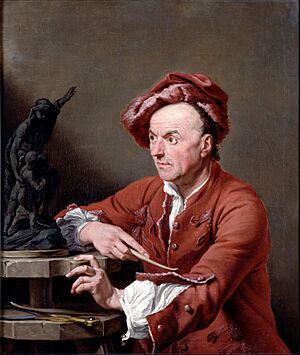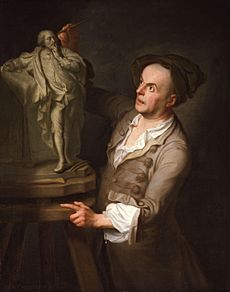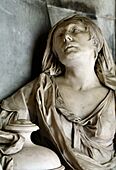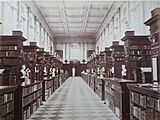Louis-François Roubiliac facts for kids
Quick facts for kids
Louis-François Roubiliac
|
|
|---|---|
 |
|
| Born | 31 August 1702 Lyon, France
|
| Died | 11 January 1762 |
| Nationality | French |
| Education | Studio of Balthasar Permoser |
| Known for | Rococo sculpture |
| Spouse(s) | Caroline Magdalene Hélot |

Louis-François Roubiliac (born August 31, 1702 – died January 11, 1762) was a very talented French sculptor. He moved to England and created many amazing artworks there. He was one of the top four sculptors in London during his time. These artists worked in a fancy style called Rococo. Many people, like art expert Margaret Whinney, believed he was "probably the most accomplished sculptor ever to work in England."
Discovering Louis-François Roubiliac
Louis-François Roubiliac was a master of sculpture. He created lifelike statues and monuments. His art captured feelings and movement. He is known for his detailed and dramatic works.
Early Life and Training
Roubiliac was born in Lyon, France. He learned his craft from skilled teachers. One of his first teachers was Balthasar Permoser in Dresden. Permoser had learned from the famous sculptor Bernini. Later, Roubiliac studied in Paris with Nicolas Coustou.
In 1730, Roubiliac entered a big art competition. He hoped to win a chance to study in Rome. He got second place, which was good, but it meant he couldn't go to Rome. So, he decided to move to London instead. In 1735, he married Caroline Magdalene Hélot. She was part of the French Huguenot community in London.
Starting His Career in London
When Roubiliac first arrived in London, he worked for a sculptor named Thomas Carter. Soon, he met Edward Walpole. Edward was the son of the Prime Minister, Robert Walpole. Edward introduced Roubiliac to Henry Cheere, another sculptor. Cheere hired Roubiliac as an assistant.
Thanks to Edward Walpole, Roubiliac got some important jobs. He made several busts for Trinity College, Dublin. He also got a big project to create a monument for the Duke of Argyll. These early works helped him become known.
The Famous Handel Statue
In 1738, Roubiliac created a statue that made him very famous. It was a seated figure of the composer George Frideric Handel. This statue was for the Vauxhall Gardens. These gardens were a popular place for people to visit.
The statue of Handel was special because it mixed real-life details with artistic ideas. Handel wore modern clothes, but he played an ancient Greek lyre. A small angel-like figure, called a putto, sat at his feet. This statue is now at the Victoria and Albert Museum. Its placement in the popular gardens made Roubiliac a well-known artist. He then opened his own studio in St Martin's Lane.
A Community of Artists
Roubiliac was a founding member of the St Martin's Lane Academy. This was a group of Rococo artists. They met at his studio. This group was an early version of the Royal Academy. Its members were close friends. They even gathered for Roubiliac's funeral.
Creating Church Monuments
For many years, Roubiliac made money by sculpting busts and monuments for churches. In 1745, he received his first major commission for Westminster Abbey. This was a funeral monument for the Duke of Argyll. It was finished in 1749.
Many people admired this monument. One art expert, George Vertue, said it showed Roubiliac's "greatness of his genius." He thought it was better than any other sculptures made in the past fifty years. The monument included a sad figure called Eloquence. This figure was seen as a powerful example of Roubiliac's skill.
Roubiliac also created monuments for important people in country churches. For example, he made monuments for the Duke and Duchess of Montagu. These are in the church at Warkton, Northamptonshire.
Later Works and Legacy
Around the mid-1700s, Roubiliac also worked at the Chelsea porcelain factory. This was a new way for sculptors to use their talents. He even sculpted figures for his friend, the painter Thomas Hudson. He also made a portrait of his friend William Hogarth's dog, "Trump." This dog portrait was later made into porcelain figures.
After his second wife passed away, Roubiliac took a short trip to Italy in 1752. He traveled with other artists.
After Roubiliac died in 1762, his studio contents were sold. Many of his plaster and clay models were bought by Dr. Matthew Maty. He gave them to the new British Museum. Roubiliac was buried in the church of St Martin-in-the-Fields. This was the same church where he had been married.
Key Sculptures by Roubiliac
Roubiliac was mainly known for his portrait busts. He also created many monuments for churches. These were the main types of sculptures made in Britain at that time. He also made some full-length statues.
Famous Works in Westminster Abbey
Some of his most important works are in Westminster Abbey. These include monuments for:
- The Duke of Argyll (1748) – This work first made him famous.
- George Frideric Handel (1761)
- Sir Peter Warren
- Field Marshal Wade
- General Fleming
- General William Hargrave
- Lady Elizabeth Nightingale (1761)
Statues and Busts in Cambridge
At Cambridge University, Roubiliac made statues of:
- King George I in the Senate House
- The Duke of Somerset
- Sir Isaac Newton
Trinity College, Cambridge, has many busts by Roubiliac. These are of important members of the college. He also created the statue of King George II in Golden Square, London.
Shakespeare Sculptures
Roubiliac also sculpted a famous bust of William Shakespeare. It is known as the Davenant bust. It is now owned by the Garrick Club in London.
He also created a full statue of Shakespeare in 1758. This was for the actor David Garrick. Garrick wanted it for his garden shrine to Shakespeare. Garrick later gave the statue to the English nation. It is now in the British Museum. A smaller clay model of this statue, made in 1757, is at the Victoria and Albert Museum.
- Works
-
Handel (Victoria and Albert Museum)
-
Dr Richard Bentley (1756), one of Roubiliac's marble busts for Trinity College, Cambridge





